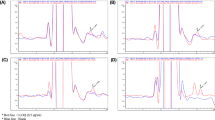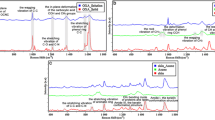Abstract
Purpose
The purpose of this study was to demonstrate the use of near-infrared (NIR) spectrometry for the in vitro quantification of econazole nitrate (EN) and estradiol (EST) in human skin.
Methods
NIR spectra were collected from EN and EST powders to verify the presence of NIR chromophores. One percent EN cream, a saturated solution of EN, or 0.25% EST solution was applied to human skin. NIR spectra were collected and one-point net analyte signal (NAS) multivariate calibration was used to predict the drug concentrations. NIR results were validated against known skin concentrations measured by high-pressure liquid chromatography (HPLC) analysis of solvent extracts.
Results
NIR spectroscopy measured dermal absorption from saturated solutions of EN on human skin with an r2 = 0.990, standard error of estimation (SEE) = 2.46%, and a standard error of performance (SEP) = 3.55%, EN cream on skin with an r2 = 0.987, SEE = 2.30%, and SEP = 2.66%, and 0.25% solutions of EST on skin with an r2 = 0.987, SEE = 3.30%, and SEP = 5.66%. Despite low permeation amounts of both drugs through the stratum corneum into human tissue, the NIR signal-to-noise ratio was greater than three, even for the lowest concentrations.
Conclusion
NIR analyses paralleled the results obtained from HPLC, and thus could serve as a viable alternative for measuring the topical bioavailability/bioequivalence of different EN and EST formulations. Because these experiments were conducted in human tissue, this research suggests an all-optical in vivo method of measurement for dermal absorption could be developed.







Similar content being viewed by others
References
L. K. Pershing, J. L. Nelson, J. L. Corlett, S. P. Shrivastava, D. B. Hare, and V. Shah. Assessment of dermatopharmacokinetic approach in the bioequivalence determination of topical tretinoin gel products. J. Am. Acad. Dermatol. 48(5):740–751 (2003).
M. Kreilgaard, M. B. Kemme, J. Burggraaf, R. C. Schoemaker, and A. F. Cohen. Influence of a microemulsion vehicle on cutaneous bioequivalence of a lipophilic model drug assessed by microdialysis and pharmacodynamics. Pharm. Res. 18(5):593–599 (2001).
D. Wierenga and C. R. Eaton. Phases of product development—drug development and approval process. Alliance Pharmaceutical Corporation. Retrieved March 23, 2006. <http://www.allp.com/drug_dev.htm>.
F. Pirot, Y. N. Kalia, A. L. Stinchcomb, G. Keating, A. Bung, and R. H. Guy. Characterization of the permeability barrier of human skin in vivo. Proc. Natl. Acad. Sci. USA 94:1562–1567 (1997).
A. L. Stinchcomb, F. Pirot, G. D. Touraille, A. L. Bunge, and R. H. Guy. Chemical uptake into human stratum corneum in vivo from volatile and non-volatile solvents. Pharm. Res. 16(8):1288–1293 (1999).
M. B. Reddy, A. L. Stinchcomb, R. H. Guy, and A. L. Bunge. Determining dermal absorption parameters in vivo from tape strip data. Pharm. Res. 19(3):292–298 (2002).
J. Medendorp, J. Yedluri, D. C. Hammell, T. Ji, R. A. Lodder, and A. L. Stinchcomb. Near infrared spectrometry for the quantification of dermal absorption of econazole nitrate and 4-cyanophenol. Pharm. Res. 23(4):835–843 (2006).
A. Urbas, M. W. Manning, A. Daugherty, L. A. Cassis, and R. A. Lodder. Near-infrared spectrometry of abdominal aortic aneurysm in the ApoE−/− mouse. Anal. Chem. 75:3650–3655 (2003).
B. Dai, A. Urbas, and R. A. Lodder. Sensor batteries: implantable sensor batteries. NIR News 17(1):14–15 (2006).
Introduction to NIR technology. Analytical Spectral Devices, Inc. Retrieved February 12, 2006. http://www.asdi.com/ASD-600510_NIR-Introduction.pdf.
H. M. Boelens, W. T Kok, O. E. Noord, and A. K. Smilde. Performance optimization of spectroscopic process analyzers. Anal. Chem. 76:2656–2663 (2004).
A. Lorber. Error propagation and figures of merit for quantification by solving matrix equations. Anal. Chem. 58:1167–1172 (1988).
K. S. Booksh, and B. R. Kowalski. Theory of analytical chemistry. Anal. Chem. 66(15):782a–791a (1994).
A. Lorber, K. Faber, and B. R. Kowalski. Net analyte signal calculation in multivariate calibration. Anal. Chem. 69(8):1620–1626 (1997).
W. Fountain, K. Dumstorf, A. E. Lowell, R. A. Lodder, and R. J. Mumper. Near-infrared spectroscopy for the determination of testosterone in thin-film composites. J. Pharm. Biomed. Anal. 33(2)1:181–189 (2003).
R. A. Lodder, M. Selby, and G. Hieftje. Detection of capsule tampering by near-infrared reflectance analysis. Anal. Chem. 59:1921–1930 (1987).
I. T. Jolliffe. Principal Component Analysis. Springer, Berlin Heidelberg New York, 2002.
R. Leardi and L. Norgaard. Sequential application of backward interval partial least squares and genetic algorithms for the selection of relevant spectra regions. J. Chemom. 18:486–497 (2004).
O. E. Noord. Elimination of uninformative variables for multivariate calibration. Anal. Chem. 68:3851–3858 (1996).
K. C. Moon, R. C. Wester, and H. I. Maibach. Diseased skin models in the hairless guinea pig skin: in vivo percutaneous absorption. Dermatologica 180:8–12 (1999).
R. Panchagnula, K. Stemmer, and W. A. Ritschel. Animal models for transdermal drug delivery. Methods Find. Exp. Clin. Pharmacol. 19:335–341 (1997).
L. L. Ferry, G. Argentieri, and D. H. Lochner. The comparative histology of porcine and guinea pig skin with respect to iontophoretic drug delivery. Pharm. Acta Helv. 70:43–56 (1995).
X. Jia, Z. Zhu, and C. Li. Immune and biochemical analysis of protein of homogenates of three different kinds of skin. Zhonghua Zheng Xing Shao Shang Waike Za Zhi 12(1):51–53 (1996).
Acknowledgment
This research was sponsored by the Food and Drug Administration, contract number D3 922004.
Author information
Authors and Affiliations
Corresponding author
Rights and permissions
About this article
Cite this article
Medendorp, J.P., Paudel, K.S., Lodder, R.A. et al. Near Infrared Spectrometry for the Quantification of Human Dermal Absorption of Econazole Nitrate and Estradiol. Pharm Res 24, 186–193 (2007). https://doi.org/10.1007/s11095-006-9140-0
Received:
Accepted:
Published:
Issue Date:
DOI: https://doi.org/10.1007/s11095-006-9140-0




